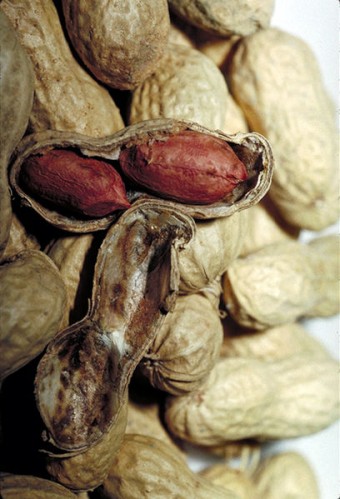Peanuts Are Not Nuts
Peanuts are a food with an identity crisis. While most people think of peanuts as nuts, they are actually legumes. What is a legume? It is a type of plant with seeds that grow inside pods such as peas or beans. Unlike nuts, which are grown on trees, peanuts grow underground. Peanut seeds flower above ground and then migrate underground to reach maturity. They are removed from the ground during harvesting. Peanuts are also called goobers, goober peas, groundnuts, earthnuts, monkey nuts, and grass nuts.
Peanut Fact by Numbers:
- How big is the average peanut farm? 100 acres
- How many peanuts does it take to make one 12-ounce jar of peanut butter? 540
- How many jars of peanut butter does the world’s largest peanut butter factory produce in a day? 250,000
- How many peanut butter sandwiches can be made from one acre of grown peanuts? 30,000
- How many peanut butter and jelly sandwiches will the average 18-year-old eat in his life? 1,500
Bonus Facts:
- India and China are the world’s largest producers of peanuts, with the United States coming in third.
- In the early 1900s, peanuts replaced cotton as the leading cash crop for farmers in the South.
- The primary use of peanuts in the United States is for peanut butter.
- The average American consumes more than six pounds of peanuts and peanut butter products each year.
- In the United States, any “peanut butter” branded product must be at least 90 percent peanuts. It’s required by law.
- Thomas Jefferson and Jimmy Carter – elected presidents of the United States – were peanut farmers.
- Ever wonder about the secret behind TV’s beloved talking horse, Mr. Ed?
Yep, you guessed it, peanut butter.It turns out, Alan Young, the actor who played the owner of Mr. Ed a few years ago admitted that he made the peanut butter story up, and in fact it was a piece of nylon placed under the horse’s tongue attached to a string that did the trick. - Dr. George Washington Carver, considered the father of the peanut industry, researched and developed more than 300 uses for peanuts in the early 1900s. He could serve an entire dinner in which all the food was made from peanuts, including soup, meat, vegetables, milk, ice cream, and coffee.
- The term “peanut gallery” originated in the late 19th century and refers to the “cheap seats”, or balcony seats, in a theater. In response to a bad performer, this rowdy crowd was known to target the stage by throwing the most common and cheap snack sold in the theater – peanuts.
- Due to the danger of the sport, race car drivers are known for their superstitions. Many race car drivers have banned the presence of shelled peanuts from their cockpits due to two unfortunate crashes in 1937 that each resulted in casualties, including two race car drivers. Afterwards, rumors spread about the presence of peanut shells on the scene, which sparked the superstition among race car drivers that peanuts in the shell are very bad luck indeed.
- The Peanuts cartoon, featuring Charlie Brown, was originally name Li’l Folks, but changed its name to Peanuts to differentiate it from other similarly named comics. The name Peanuts was based on Howdy Doody’s peanut gallery – an onstage audience of 40 kids. The peanut gallery referred to a nice lively crowd rather than the heckling crowd of the theater. The creator of the Charlie Brown comics, Charles M. Schulz, always disliked the name Peanuts.
No year would be complete without a few respectable peanut holidays:
- January 24th – National Peanut Butter Day
- March – National Peanut Month
- March 1st – National Peanut Butter Lover’s Day
- March 8th – National Peanut Cluster Day
- April 2nd – National Peanut Butter and Jelly Day
- May 18th – I Love Reese’s Day
- June 12th – National Peanut Butter Cookie Day
- September 13th – National Peanut Day
- November – National Peanut Butter Lover’s Month
- November 20th – National Peanut Butter Fudge Day
| Share the Knowledge! |
|






The Bonus “Fact” about Mister Ed being manipulated with Peanut Butter is likely False:
http://legendsrevealed.com/entertainment/2013/07/01/was-peanut-butter-used-to-make-mister-ed-talk/
@Ron: Interesting stuff. Turns out you can’t even trust the main actor on the show, who is the one who originally said it was peanut butter (Alan Young)
Maybe he was joking. An old phrase, “pulling your leg,” comes to mind.
Probably how Alan Young was enticed to act not Bamboo Harvester (Mr. Ed’s real name)….Young must have assumed as much.
Why are the days not in the months? Like, peanut butter lover’s day is not in peanut butter lover’s month, and same goes with just the peanut. I just think that’s a little messed up. Who do I have to contact about official holidays to correct this grave f**k up of epic proportions? Cuz this is honestly just insane!